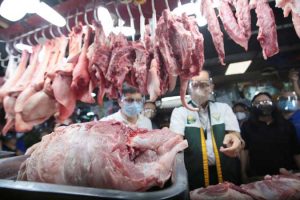THE Department of Agriculture (DA) said on Monday that it will implement a maximum suggested retail price (MSRP) for pork by March, adding that it considers P380 per kilo to be a fair price for producers and consumers.
At a briefing, DA Assistant Secretary Arnel V. de Mesa said it will adopt the pricing rules for rice to the pork MSRP.
“When we set the MSRP, retailers will follow and we will avoid profiteering or charging high prices,” he said.
The DA is set to meet with the pork industry this week.
The assumptions underlying the MSRP scheme are a farmgate price of P250 per kilo and a “reasonable” margin that takes the retail price to P380, Mr. De Mesa said.
He cited previous remarks by Agriculture Secretary Francisco Tiu Laurel, Jr., who took the position that anything above P400 is “unreasonable.”
The Samahang Industriya ng Agrikultura (SINAG) told BusinessWorld that pork prices in Metro Manila often hit P400 per kilo, even with a P240-250 farmgate price.
“The price of pork should not go beyond P360-P380 per kilo,” SINAG spokesman Jay Cainglet said via Viber.
Mr. De Mesa said about 30,000 hogs have been vaccinated against African Swine Fever (ASF).
The government began the controlled rollout of Vietnam-made ASF vaccines in late August, with a focus on hogs in Lobo, Batangas, which is one of the hotspots for the disease.
Former Agriculture Secretary William A. Dar told BusinessWorld earlier this month that weak supply is to blame for rising prices since the farmgate price remains low.
Mr. Laurel on Feb. 10 said the DA is “digging deep into the whole value chain of pork, and finding out whether or not there is profiteering.”
Mr. De Mesa said the DA is also considering selling below-market pork modeled on the government’s Rice for All program.
“We are also looking in the possibility that DA can also intervene,” he said.
At the briefing, the DA added that onion prices have fallen by as much as P40 per kilo.
Onion was selling for about P200 per kilo this week from P240 last week, Mr. De Mesa said.
“We expect that these will further decrease once (imported) yellow and red onions enter the markets,” he said.
The DA had approved onion imports of 4,000 MT after projecting a shortfall in supply of 7,000 MT. Applications to import thus far suggest import volumes of only 3,000 MT, according to Mr. De Mesa.
“Must-arrive date is Feb. 20,” he said. — Kyle Aristophere T. Atienza

